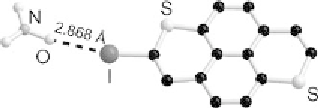Chemistry Reference
In-Depth Information
the monoiododithiapyrene DTPY-I, when compared with the diodo deriva-
tive DTPY-I
2
, allowed for its successful electrocrystallization with NO
3
-
or
chemical oxidation with various quinones (Fig. 13). The short and linear
C - I
O - NO
2
-
interaction identified in its 1 : 1 nitrate salt demonstrates
that any donor molecule substituted with a bromide or iodine atom is po-
tentially able to enter into a halogen bond interaction upon oxidation to the
cation radical state.
···
O - NO
2
-
interaction in (DTPY-I)NO
3
Fig. 13
AdetailoftheC- I
···
3.4
Ternary Systems
Following Dehnicke's report in 1996 on the co-crystallization of diiodoacety-
lene (DIA) with various halide anions to form two-dimensional networks
through C - I
X
-
interactions [93], Kato et al. investigated these supramo-
lecular anions in the electrocrystallization of classical TTFs such as BEDT-
TTF.
Highly conducting 2 : 1 BEDT-TTF salts were obtained with diiodoacety-
lene with chains of alternating DIA neutral molecules and X
-
anions
(Scheme 13) [94]. Increasing the size of the neutral molecules with difluorote-
traiodobenzene (DFTIB) or 1,4-(bisiodoethynyl)benzene (pBIB) decreases
the overall charge per surface unit in the anionic layer, thus affording
3:1 salts such as (BEDT-TTF)
3
X(DFTIB) or (BEDT-TTF)
3
X(pBIB),X=
Cl, Br [95]. These salts exhibit a two-dimensional character and a metallic
conductivity down to 1.6 K. Other donor molecules derived from BEDT-
TTF are also currently being investigated, such as bis(methylenedithio)-
tetrathiafulvalene (BMDT-TTF) [96]. With the latter, slightly smaller than
BEDT-TTF, a 4 : 1 salt was isolated in the presence of difluorobis(iodoethynyl)
benzene and Cl
-
or Br
-
.
···
4
Summary and Outlook
This short review has demonstrated that halogen bonding interactions have
already been used in many ways in the field of magnetic or conducting or-
ganic systems. Only a few examples are available in the nitroxide family, but

Search WWH ::

Custom Search